
Glenda Farrell was an American actress. Farrell personified the smart and sassy, wisecracking blonde of the Classic Hollywood films. Farrell's career spanned more than 50 years, appearing in numerous Broadway plays, films and television series. She won an Emmy Award in 1963 for Outstanding Supporting Actress for her performance as Martha Morrison in the medical drama television series Ben Casey.
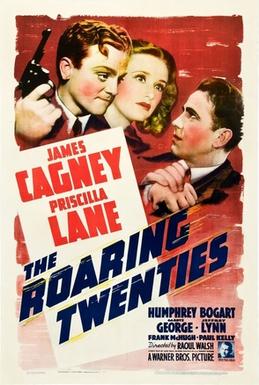
The Roaring Twenties is a 1939 American crime thriller film directed by Raoul Walsh and starring James Cagney, Priscilla Lane, Humphrey Bogart, and Gladys George. The film, spanning the period from 1919 to 1933, was written by Jerry Wald, Richard Macaulay and Robert Rossen. The film follows three men and their experiences during major events in the 1920s, such as Prohibition era violence and the 1929 stock market crash.
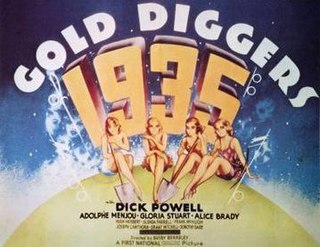
Gold Diggers of 1935 is an American musical film directed and choreographed by Busby Berkeley, his first time as a film's overall director. It stars Dick Powell, Adolphe Menjou, Gloria Stuart, Alice Brady, Hugh Herbert, Glenda Farrell, and Frank McHugh, and features Joseph Cawthorn, Grant Mitchell, Dorothy Dare, and Winifred Shaw. The songs were written by Harry Warren (music) and Al Dubin (lyrics). The film is best known for its famous "Lullaby of Broadway" production number. That song, sung by Shaw, also won the Academy Award for Best Original Song. The screenplay was by Manuel Seff and Peter Milne, based on a story by Robert Lord, who also produced the film, and Milne.
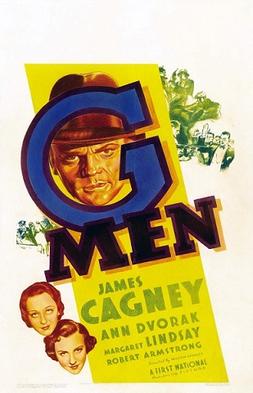
G Men is a 1935 Warner Bros. crime film starring James Cagney, Ann Dvorak, Margaret Lindsay and Lloyd Nolan in his film debut. According to Variety, the movie was one of the top-grossing films of 1935. The supporting cast features Robert Armstrong and Barton MacLane.
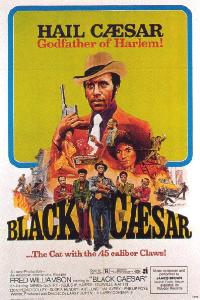
Black Caesar is a 1973 American blaxploitation crime drama film written and directed by Larry Cohen and starring Fred Williamson, Gloria Hendry and Julius Harris. It features a musical score by James Brown, his first experience with writing music for film. A sequel titled Hell Up in Harlem was released in late 1973.
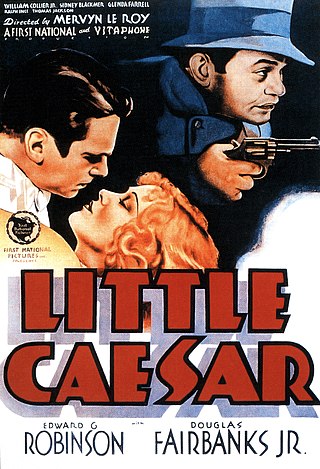
Little Caesar is a 1931 American pre-Code crime film distributed by Warner Brothers, directed by Mervyn LeRoy, and starring Edward G. Robinson, Glenda Farrell, and Douglas Fairbanks Jr. The film tells the story of a hoodlum who ascends the ranks of organized crime until he reaches its upper echelons. The storyline, based on real life Mafia boss Salvatore Maranzano, was adapted from the novel of the same name by William R. Burnett. Little Caesar was Robinson's breakthrough role and immediately made him a major film star. The film is often listed as one of the first fully-fledged gangster films and continues to be well received by critics.
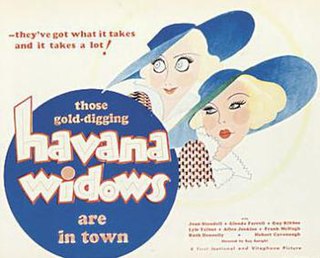
Havana Widows is a 1933 American pre-Code comedy film directed by Ray Enright, starring Joan Blondell and Glenda Farrell. It was released by Warner Bros. on November 18, 1933. Two chorus girls travel to Havana in search of rich husbands. Their target is Deacon Jones, a self-appointed moralist who cannot drink without getting drunk.
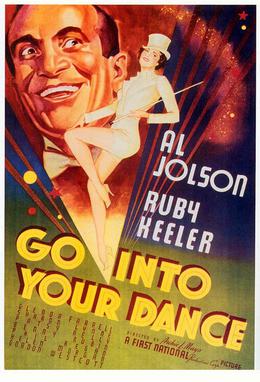
Go into Your Dance is a 1935 American musical drama film starring Al Jolson, Ruby Keeler, and Glenda Farrell. The film was directed by Archie Mayo and is based on the novel of the same name by Bradford Ropes. It was released by Warner Bros. on April 20, 1935. An irresponsible Broadway star gets mixed up with gambling and gangsters.

I Found Stella Parish is a 1935 American melodrama film directed by Mervyn LeRoy and starring Kay Francis, Ian Hunter and Paul Lukas. It was produced by Warner Bros. and shot at the company's Burbank Studios. Francis plays a celebrated actress whose dark secret is revealed to the world.

Sybil Jason was an American child film actress who, in the late 1930s, was presented as a rival to Shirley Temple.

Star of Midnight is a 1935 American mystery comedy film directed by Stephen Roberts. William Powell was loaned to RKO Pictures from MGM to star with Ginger Rogers.

Prison Break is a 1938 American crime-drama film directed by Arthur Lubin and starring Barton MacLane, Glenda Farrell and Paul Hurst. The film was based on the story "Walls of San Quentin" by Norton S. Parker. It was released by Universal Pictures on July 12, 1938.
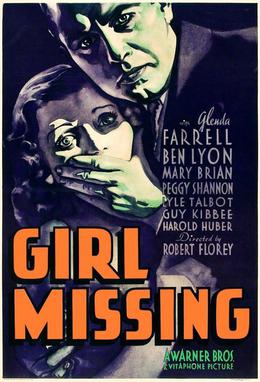
Girl Missing is a 1933 American pre-Code mystery film starring Glenda Farrell, Ben Lyon and Mary Brian. It was directed by Robert Florey and released by Warner Bros. on March 4, 1933.

Miss Pacific Fleet is a 1935 American comedy film directed by Ray Enright. The film stars Joan Blondell, Glenda Farrell, and Hugh Herbert. The film was based on the short story of the same name by Frederick Hazlitt Brennan in the Collier's magazine. It was released by Warner Bros. on December 14, 1935. Two stranded showgirls in California enter a beauty contest "Miss Pacific Fleet" to win the fare back home to New York City.
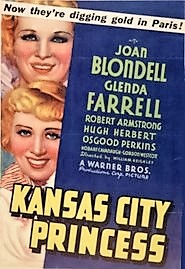
Kansas City Princess is a 1934 American comedy film starring Joan Blondell and Glenda Farrell. The film was directed by William Keighley with a script written by Sy Bartlett and Manuel Seff.

Smart Blonde is a 1937 American mystery film directed by Frank McDonald. Starring Glenda Farrell as Torchy Blane, a fast-talking wisecracking female reporter, teaming up with her boyfriend detective Steve McBride, to solve the killing of an investor who just bought a popular local nightclub.

Traveling Saleslady is a 1935 American comedy film directed by Ray Enright and starring Joan Blondell and Glenda Farrell. It was released by Warner Bros. on March 28, 1935. It is one of five films by Warner Bros. where Farrell and Blondell were paired as two blonde bombshells. The other films include: Havana Widows (1933), Kansas City Princess (1934), We're in the Money (1935) and Miss Pacific Fleet (1935). Actress Joan Blondell was married to the film's cinematographer George Barnes at the time of filming.

Hi, Nellie! is a 1934 American crime drama film directed by Mervyn LeRoy and starring Paul Muni and Glenda Farrell. A newspaper editor is demoted to writing an advice column for refusing to go along with the crowd in declaring a missing lawyer to be a thief.
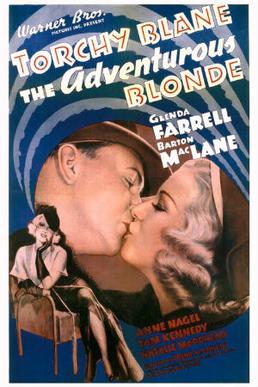
The Adventurous Blonde is a 1937 American comedy mystery film directed by Frank McDonald and starring Glenda Farrell, Barton MacLane and Anne Nagel. It was written by Robertson White and David Diamond. It was released on November 13, 1937.

Exposed is a 1938 American drama film starring Glenda Farrell, Otto Kruger and Herbert Mundin. The film was directed by Harold D. Schuster and is based on George R. Bilson's unpublished story "Candid Camera Girl". It was released by Universal Pictures on November 4, 1938. A magazine photo-newswoman tried to make amends after exposing a lawyer and complication ensues when they fall in love.




















